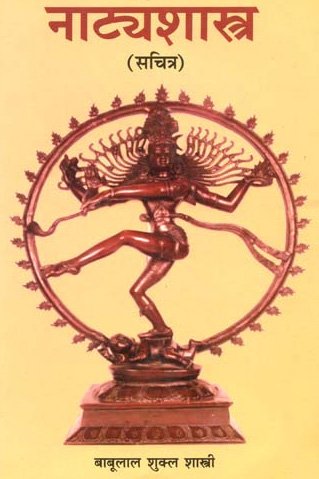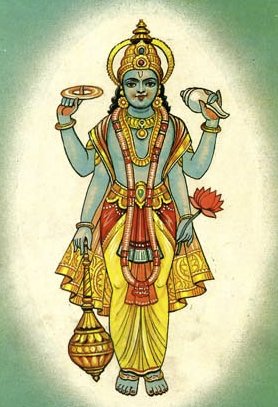Anugata: 16 definitions
Introduction:
Anugata means something in Buddhism, Pali, Hinduism, Sanskrit, Hindi. If you want to know the exact meaning, history, etymology or English translation of this term then check out the descriptions on this page. Add your comment or reference to a book if you want to contribute to this summary article.
Alternative spellings of this word include Anugat.
In Hinduism
Natyashastra (theatrics and dramaturgy)
Source: Wisdom Library: Nāṭya-śāstra1) Anugata (अनुगत) refers to a variety of music to be produced from the vīṇā (musical instrument), according to the Nāṭyaśāstra chapter 29. The vīṇā refers to a musical instrument, inhibiting various dhātus (finger techniques).
According to the Nāṭyaśāstra, “the instrumental music which follows the song, is called the anugata. The rule in the playing of musical instruments, is that the anugata in a medium tempo. The experts in observing tempo and time-measure, should apply the anugata in the second song to be sound during a performance”.
2) Anugata (अनुगत) or Ghana refers to one of the three gatas: rules used in the playing of drums (puṣkara) [with reference to Mṛdaṅga, Paṇava and Dardura] according to the Nāṭyaśāstra chapter 33. Accordingly, “the anugata playing of drums, should begin with the sama-pāṇi or the avara-pāṇi, and it should have karaṇas produced by distinct strokes, and it should follow the song”.

Natyashastra (नाट्यशास्त्र, nāṭyaśāstra) refers to both the ancient Indian tradition (shastra) of performing arts, (natya—theatrics, drama, dance, music), as well as the name of a Sanskrit work dealing with these subjects. It also teaches the rules for composing Dramatic plays (nataka), construction and performance of Theater, and Poetic works (kavya).
Vaishnavism (Vaishava dharma)
Source: Brill: Śaivism and the Tantric Traditions (vaishnavism)Anugata (अनुगत) refers to “possessing (many branches)”, according to the Vedānta Deśika’s Yatirājasaptati.—There are allusions to Rāmānuja’s “protection” of the Vedas, his defeat of those who hold other Vedāntic views as well as the significance of his establishment of the right interpretation of the Vedas in innumerable verses of the Yatirājasaptati. [...] Verse 31 captures in a lovely set of images the nature of Rāmānuja’s works.They are wish-fulfilling trees for the imagination of debaters, oozing with the nectar of Hari’s feet, possessing many branches (anugata-bahuśākha) so that they can remove suffering/heat, and subduing (with their perfume) the stench of sins.

Vaishnava (वैष्णव, vaiṣṇava) or vaishnavism (vaiṣṇavism) represents a tradition of Hinduism worshipping Vishnu as the supreme Lord. Similar to the Shaktism and Shaivism traditions, Vaishnavism also developed as an individual movement, famous for its exposition of the dashavatara (‘ten avatars of Vishnu’).
In Buddhism
Mahayana (major branch of Buddhism)
Source: academia.edu: A Study and Translation of the GaganagañjaparipṛcchāAnugata (अनुगत) refers to “(that which is) in accordance with”, according to the Gaganagañjaparipṛcchā: the eighth chapter of the Mahāsaṃnipāta (a collection of Mahāyāna Buddhist Sūtras).—Accordingly, “[...] Son of good family, how does the recollection of morality (śīlānusmṛti) of Bodhisattva becomes like open space? [...] Since there is no visual form, it is praised by the wise. Since it appeases vices, there is no essential characteristic of recognition. Since it is in accordance with all happiness (sarva-sukha-anugata) and is not generated by the contrary, while recollecting this morality, there is no impurity in the recollection. Son of good family, this is what is called the recollection of morality which is authorized by the Lord”.

Mahayana (महायान, mahāyāna) is a major branch of Buddhism focusing on the path of a Bodhisattva (spiritual aspirants/ enlightened beings). Extant literature is vast and primarely composed in the Sanskrit language. There are many sūtras of which some of the earliest are the various Prajñāpāramitā sūtras.
Languages of India and abroad
Pali-English dictionary
Source: BuddhaSasana: Concise Pali-English Dictionaryanugata : (pp. of anugacchati) accompanied by; gone into.
Source: Sutta: The Pali Text Society's Pali-English DictionaryAnugata, (adj.) (pp. of anugacchati) gone after, accompanied by, come to; following; fig. fallen or gone into, affected with (-°), being a victim of, suffering M.I, 16; D.III, 85, 173 (parisā); A.II, 185 (sota°, v. l. anudhata); J.II, 292 (samudda°); v.369; Nd2 32 (taṇhā°); PvA.102 (nāmaṃ mayhaṃ a. has been given to me), 133 (kammaphala°). (Page 34)

Pali is the language of the Tipiṭaka, which is the sacred canon of Theravāda Buddhism and contains much of the Buddha’s speech. Closeley related to Sanskrit, both languages are used interchangeably between religions.
Sanskrit dictionary
Source: DDSA: The practical Sanskrit-English dictionaryAnugata (अनुगत).—p. p.
1) (Used passively) (a) Followed (lit. & fig.), attended; अनुगतमलिवृन्दैर्गण्डभित्तीर्विहाय (anugatamalivṛndairgaṇḍabhittīrvihāya) R.12. 12; M.3.9; मद्यानुगतभोजनं मलावहम् (madyānugatabhojanaṃ malāvaham) Manusmṛti 11.7. (b) Full of, filled with; दारिद्य्रेणाभिभूतेन त्वत्स्नेहानुगतेन च (dāridyreṇābhibhūtena tvatsnehānugatena ca) Mṛcchakaṭika 4.5; वर्ष- धरकलमूकानुगतेन परिजनेन (varṣa- dharakalamūkānugatena parijanena) K.159 consisting or made up of; चिन्तानुगतसर्वात्मन् (cintānugatasarvātman) Mb. (c) Covered, as by a dress hanging behind; शिवमिवानुगतं गजचर्मणा (śivamivānugataṃ gajacarmaṇā) Kirātārjunīya 5.2 (paścādvyāptam). (d) Extinguished &c. (e) Acquired, obtained. (f) Overtaken; कालेनानुगतो ह्यसि (kālenānugato hyasi) Rām.7.68.6.
2) (Used actively) (a). Following, obeying; observing; स्वमत- मनुगतः (svamata- manugataḥ) Mu.5.19; विभवानुगता भार्या (vibhavānugatā bhāryā) Mṛcchakaṭika 3.28; दिग्विजय- प्रसङ्गेनानुगतो भूमिमिमाम् (digvijaya- prasaṅgenānugato bhūmimimām) K.191 come to; Manusmṛti 9.267; K.166; Mu.6.5; H.2.55; R.15.9. (b) Corresponding or tallying with, adapted or answering to, in harmony with; सूत्रेणानुगतं भवति (sūtreṇānugataṃ bhavati) Ś.B.; पादन्यासो लय- मनुगतः (pādanyāso laya- manugataḥ) M.2.8 in accompaniment to the musical time. मृदङ्ग °तः सङ्गीतमधुरः (mṛdaṅga °taḥ saṅgītamadhuraḥ) Ratnāvalī 1; °वीणैः (vīṇaiḥ) Śiśupālavadha 11.1. (c) Adequate or suitable to, fit for; प्रस्तावानुगतं पृष्टः (prastāvānugataṃ pṛṣṭaḥ) Pañcatantra (Bombay) 5. (d) Imitating; परितुष्टोऽस्मि यत्पितरमनुगतो वत्सः (parituṣṭo'smi yatpitaramanugato vatsaḥ) M.5. I am glad that the boy takes after his father.
-tam Moderate time in music.
Source: Cologne Digital Sanskrit Dictionaries: Shabda-Sagara Sanskrit-English DictionaryAnugata (अनुगत).—mfn.
(-taḥ-tā-taṃ) 1. Followed literally or figuratively, as by a dependent, &c. 2. Following, a follower or a dependent. 3. Acquired, obtained. 4. Determined, defined. E. anu, and gata gone.
Source: Cologne Digital Sanskrit Dictionaries: Cappeller Sanskrit-English DictionaryAnugata (अनुगत).—[adjective] gone after, followed, visited, occupied, conquered; following, complying with, obedient; equalling, resembling (—°).
Source: Cologne Digital Sanskrit Dictionaries: Monier-Williams Sanskrit-English Dictionary1) Anugata (अनुगत):—[=anu-gata] [from anu-gam] mfn. followed by, having anything (as a skin) hanging behind
2) [v.s. ...] following
3) [v.s. ...] a follower
4) [v.s. ...] acquired
5) [v.s. ...] extinguished
6) [v.s. ...] tallying with
7) [v.s. ...] n. moderate time (in music).
Source: Cologne Digital Sanskrit Dictionaries: Goldstücker Sanskrit-English DictionaryAnugata (अनुगत):—[tatpurusha compound] 1. m. f. n.
(-taḥ-tā-tam) 1) Following, pursu-ing.
2) Followed, pursued.
3) Acquired, obtained, lit. and met.
4) Gone out, extinguished (as fire). 2. n.
(-tam) (In Music.) The middle measure, neither quick nor slow; the same as ghana q. v. E. gam with anu, kṛt aff. kta.
Source: Cologne Digital Sanskrit Dictionaries: Yates Sanskrit-English DictionaryAnugata (अनुगत):—[anu-gata] (taḥ-tā-taṃ) a. Followed; following; obtained.
Source: DDSA: Paia-sadda-mahannavo; a comprehensive Prakrit Hindi dictionary (S)Anugata (अनुगत) in the Sanskrit language is related to the Prakrit words: Aṇugamia, Aṇugaya.
[Sanskrit to German]
Sanskrit, also spelled संस्कृतम् (saṃskṛtam), is an ancient language of India commonly seen as the grandmother of the Indo-European language family (even English!). Closely allied with Prakrit and Pali, Sanskrit is more exhaustive in both grammar and terms and has the most extensive collection of literature in the world, greatly surpassing its sister-languages Greek and Latin.
Hindi dictionary
Source: DDSA: A practical Hindi-English dictionaryAnugata (अनुगत) [Also spelled anugat]:—(a) obedient; prone to obey or follow; (nm) a follower; hence ~[gati] obedience, following.
...
Kannada-English dictionary
Source: Alar: Kannada-English corpusAnugata (ಅನುಗತ):—
1) [adjective] that followed; came as a consequence; succeeded.
2) [adjective] concerned; related; pertinent.
--- OR ---
Anugata (ಅನುಗತ):—
1) [noun] a person or thing that follows; a follower.
2) [noun] the quality, state, fact or an instance of obeying or a willingness to obey; submission; obedience.
3) [noun] (pros.) a kind of alliteration, in which a particular consonant or combination of consonants repeats several times frequently.
Kannada is a Dravidian language (as opposed to the Indo-European language family) mainly spoken in the southwestern region of India.
See also (Relevant definitions)
Starts with: Anugatadharma, Anugataprasa, Anugatartha.
Ends with: Acaranugata, Anukramanugata, Gatanugata, Janugata, Kaphanugata, Paramparanugata, Phenanugata, Samanugata, Saranugata, Sarvasattvachittacharitanugata, Sarvasattvacittacaritanugata, Sotanugata, Srotonugata, Sukhanugata, Svarupanugata, Tanugata, Vamshanugata, Vattanugata, Vivadanugata, Yoganugata.
Full-text (+33): Anugatartha, Anugatika, Anugatya, Anupurusha, Gatanugata, Anusama, Anukrakaca, Anupushpa, Anugataprasa, Anukaniyams, Anugatadharma, Anugamia, Anvayatta, Anugaya, Anurahasa, Anuvya, Anushastra, Vattanugata, Sotanugata, Mastalunga.
Relevant text
Search found 14 books and stories containing Anugata, Anu-gata; (plurals include: Anugatas, gatas). You can also click to the full overview containing English textual excerpts. Below are direct links for the most relevant articles:
Elephantology and its Ancient Sanskrit Sources (by Geetha N.)
Sahitya-kaumudi by Baladeva Vidyabhushana (by Gaurapada Dāsa)
Text 9.4 [Anuprāsa] < [Chapter 9 - Ornaments of Sound]
Natyashastra (English) (by Bharata-muni)
Chapter XXXIII - On Covered Instruments (avanaddha)
Chapter XXIX - On Stringed Instruments (tata)
Part 2 - The Ancient Indian Theory and Practice of Music < [Introduction, Part 2]
A History of Indian Philosophy Volume 2 (by Surendranath Dasgupta)
Part 5 - The Foetus and the Subtle Body < [Chapter XIII - Speculations in the Medical Schools]
Part 18 - Citsukha’s Interpretations of the Concepts of Śaṅkara Vedānta < [Chapter XI - The Śaṅkara School of Vedānta (continued)]
Matangalila and Hastyayurveda (study) (by Chandrima Das)